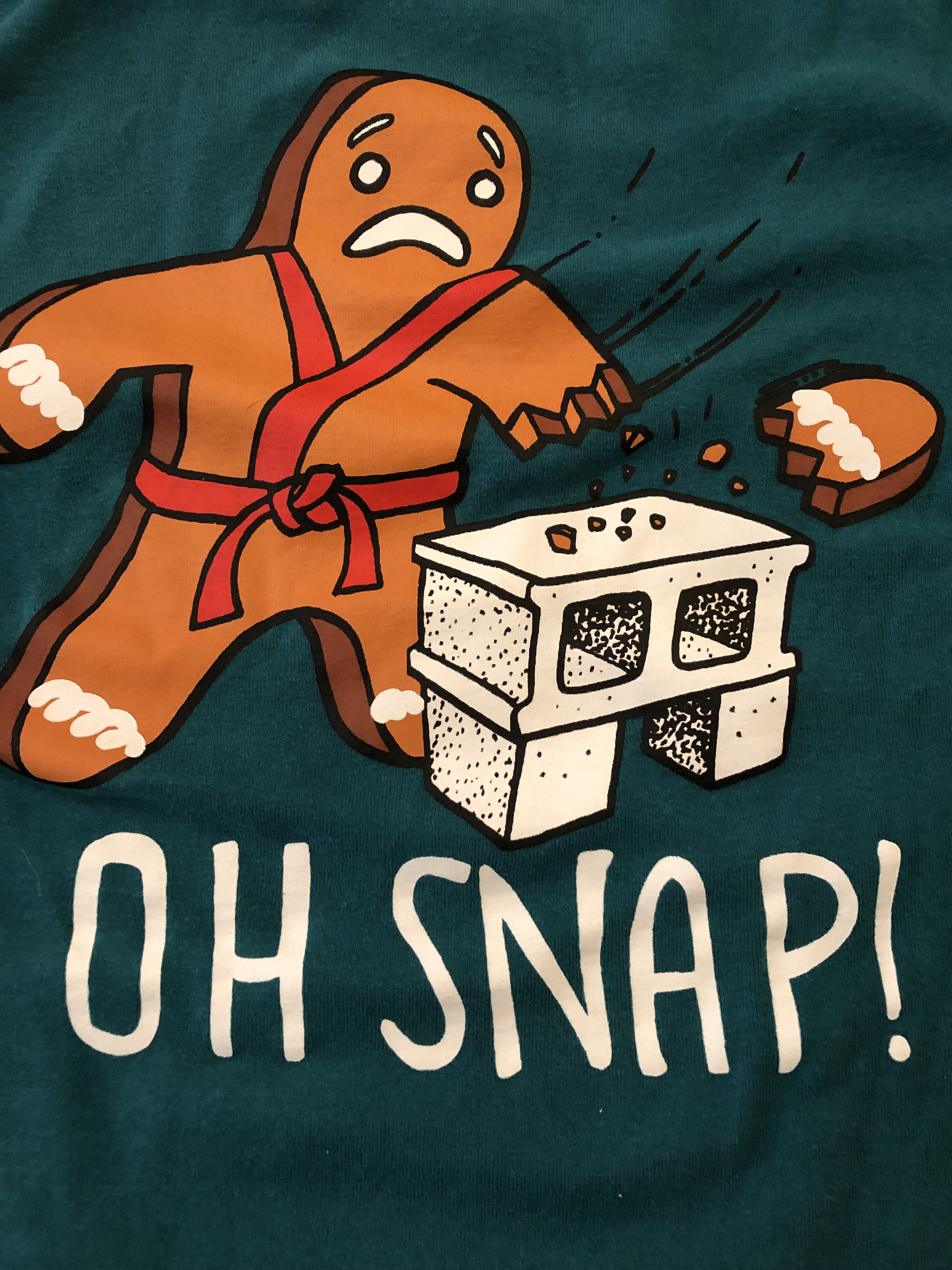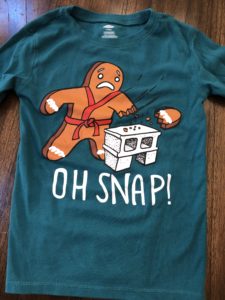
THE GINGERBREAD MAN
A DEEPER LOOK
After more than 300 years of being the main character in an iconic story, the Gingerbread man, who ran away from all those pursuers, can’t escape the stigma of being a victim. In the story, the gingerbread man jumps out of the oven and runs off in search of freedom. But the joy of freedom eludes him as he discovers that the world is a harsh place. He is constantly pursued by a series of hungry animals. He manages to outrun them, but is finally outwitted by a fox who tricks him into riding on his back across the river, then gobbles him down on the way. Perhaps this story, first published in 1875, was originally created to scare children, as many fairytales were designed to to like Little Red Riding Hood and Hansel and Gretel, which encouraged young ones to stay close to home.
The image I’m presenting here is from a shirt currently being sold in the boys section of Old Navy. As you can see, the gingerbread man is up against impossible odds; in what universe can a cookie expect to chop through cement and remain unharmed? After everything he’s been through, the Gingerbread man is wise to toughen himself up and get some martial arts training, but he is still naive in way way he’s going about things.
The question about the evolution(or devolution) of the gingerbread man started last week when I was out with my ten year old son, Alex. My son’s friend, Brad, was joining us with his parents, Jon and Barbara for dinner. We met up at Old Navy first. We were browsing when Jon and Brad came running up to us, holding up this shirt, all excited. Barbara and I immediately expressed gut-level responses to the latest plight of the Gingerbread man and verbalized our thoughts. She found it violent. I found it lacking in empathy. Jon and the boys couldn’t understand why we found it disturbing and he bought the shirt against Barbara’s wishes. During dinner, Brad proudly wore the shirt, which I had to look at for the next hour and a half. Barbara whispered to me that the shirt would be going “bye-bye”.
Over the course of the next few days Barbara and I explored the reasons why this image was offensive to us. It’s just a cartoon picture of a cookie, what’s the big deal? We tried to do it, but just couldn’t see the value of it or the humor in it.
I thought about what the symbolism of the Gingerbread man might be. He came to life with a strong impulse to be free, but he didn’t exactly enjoy his freedom. How does this translate to the human experience?
Every day—every moment!—is an opportunity to be reborn, start anew. We can alter outcomes with enlightened attitudes, actions and words. We shape ourselves like dough to become who we choose to be. We can opt to look at obstacles from different perspectives and effectively change our trajectory by focusing on what we want. This story also has lessons on being our own advocate. We must teach our children to stand up for what they believe, in a way that is constructive and strengthening. Running away from problems just makes them worse because you can’t run away from yourself and most problems can ultimately be traced back to the self—our thoughts create our beliefs which create our language which create our experiences which create our level of fulfillment.

The couple is childless and this living cookie might have been a blessing. The gingerbread man might have missed out on love and attention they would have showered him with. He didn’t even stick around to see. He ran off without hesitation into the wide world without the tools or understanding to deal with the challenges he encountered.
The gingerbread man was—and perhaps still is—naive. If he had talked with the woman or stopped and defended himself against the animals or if he had tried to strike a bargain that he could get them more cookies to eat if they would spare him, perhaps he would have survived. If he had realized the fox was deceiving him, maybe he could have run in another direction and hidden himself.
The gingerbread man on this shirt clearly has the goal to be stronger, but lacks the good judgement to do so in a constructive way. He didn’t think the consequences through. On top of that, he’s going for brute force rather than smart strategizing. As a result, he is experiencing pain and suffering once again. And we are encouraged to laugh at his misfortune.
“Oh, snap.” It’s a light-hearted phrase, to be used in the event of spilled laundry soap on your hands or dropped candy. To use it in reference to the breaking of a bone, the loss of a hand, and the pain that must follow, shows a lack of compassion and understanding.
My intention these days is to increase awareness of the world around me. Does this mean I don’t have a sense of humor? On the contrary. I love humor. But when does humor cross a line into insensitivity and cruelty? I think this image crosses that line.
If this shirt is a continuation of the plight of the gingerbread man, it has hit the mark perfectly. Trying to chop a cement block can be added to his list of bad calls. What bothers me most about this image is that a representation of low level thinking, of spinning wheels and the unwillingness to evolve. I would like to have seen one of these depictions: The gingerbread man beating the fox in a martial arts match or living happily with his family in a holiday scene.
This is an opportunity to clarify what our intentions are. I invite you to ask yourself as you go through your day, observing things: “Does this promote more love and appreciation, more compassion and understanding?” If the answer is no, then perhaps it’s not the best avenue to pursue. Maybe it’s not the best item to spend money on or the best information to expose our children to. Instead, it’s time for a heightening of our experiences, using images and words that support our best selves, our highest selves—our selves that use cement for building rather than for breaking.
